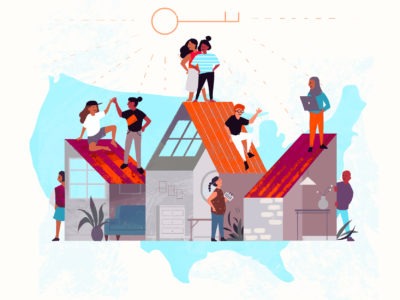Update April 8: Homeless Response Workers Face Continued Challenges During The Coronavirus Pandemic
Leaders in Built for Zero and homeless service providers across the country have been thrust onto the front lines of the COVID-19 response. Community Solutions asked the more than 80 communities in Built for Zero to share the challenges they are experiencing and what they need. The responses illustrate alarming challenges that must be immediately addressed by federal, state, and local leadership, as well as philanthropy.
We cannot leave this population and system behind. Sheltering in place is impossible for people who do not have a home. Spaces like overcrowded shelters can place people at greater risk of transmission, which is exacerbated by a lack of access to handwashing or shower stations, or even hand sanitizer and cleaning supplies. Because they are likely to be older, chronically ill, or immunocompromised, Americans experiencing homelessness are among those at highest risk of suffering severe or fatal consequences and requiring hospitalization.
People experiencing homelessness — and those serving them — cannot be neglected by the response. Here are five common concerns that we heard from leaders across the country that must be addressed immediately.

1. Homeless service providers are struggling to find spaces to ensure clients can safely quarantine or self isolate.
Our ability to contain this outbreak is contingent on the ability of people to shelter in place, quarantine vulnerable individuals, and isolate people who are ill. These pillars of the response are completely unavailable for most people experiencing homelessness.
In order to enable social distancing, homeless service providers have reduced the number of people in shelter. At the same time, many other public spaces and day-centers where clients may spend their time have closed. As a result, many communities are struggling to address the increased demand. Many communities are working to secure vacant rooms in hotels and motels, RVs, and other community spaces to expand this capacity. However, many homeless service providers need additional resources or support to secure these spaces. Federal, state, and local governments should ensure these spaces are secured immediately.

2. Frontline service providers do not have access to the personal protective equipment or other critical resources they need to safely carry out critical activities. This is creating strain on the already diminished capacity of their workforce.
Across the board, homeless service providers are concerned that they do not have access to enough personal protective equipment, gloves, and infrared thermometers for their frontline staff. Without this equipment, frontline workers cannot safely conduct activities like outreach, which means that they do not necessarily know who is dealing with symptoms. An inability to safely assess clients also undermines their potential to effectively triage and support clients, stemming inflow into hospitals.
Some providers are lacking other critical resources, such as cleaning and sanitation supplies. Some are struggling to meet basic needs like food, both because of insufficient resources and the loss of volunteers. Altogether, these gaps are compromising a workforce that is already diminished due to lockdowns, illness, and transitions to more remote operations. Some leaders expressed concerns about how they will keep facilities operating.

3. Many housing programs and housing authorities are suspending housing processes.
As agencies shift to pandemic response, helping people move into permanent housing has ground to a halt in many communities. This pandemic illustrates, as starkly as ever, that housing is health and that helping people become permanently housed will continue to be critically important.

4. State and city leadership need to establish clear authority and command structures that prioritize the homeless population.
In many communities, accountability for decision making is diffuse and reported as a critical barrier to effective local action. Leaders are seeking effective coordination and emergency management systems to direct and respond to the crisis. Leadership should assure that incident command centers are in place in every region and explicitly responsible for working with local organizations to get people experiencing homelessness to safety.

5. Homeless service providers are struggling with fear and anxiety as they respond to this unprecedented health emergency.
Leaders in our homeless response systems are experiencing fear, confusion, and anxiety. For all the previous challenges, and many more that are likely arising every day, people are concerned about the safety of the clients they serve, their peers, and themselves. Workers in local service settings are also concerned about layoffs or insolvency at their agencies. As we consider the heroic work being undertaken across the world to respond to COVID-19, we must ensure that the homeless response system — and people leading at every level of it — are protected, heard, and supported through the duration of this crisis.
Support the leaders of your homeless response system.
If you are in a Built for Zero community, you can find a list of the organizations that are leading the Built for Zero work here.




